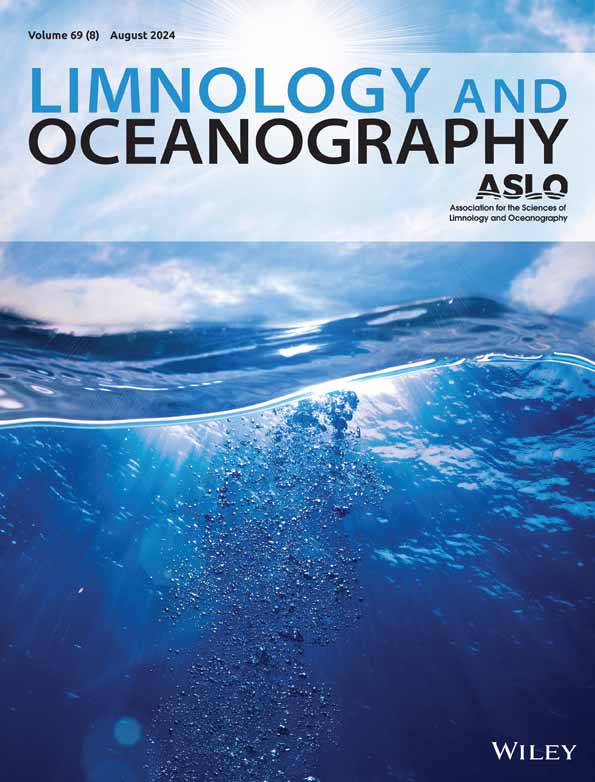Trophic strategies of freshwater nanoflagellates under variable run‐off scenarios
IF 3.7
1区 地球科学
Q1 LIMNOLOGY
引用次数: 0
Abstract
Terrestrial run‐off is increasing in temperate lakes due to climate change and can lead to loading of colored dissolved organic matter (cDOM) and nutrients, thus reducing light availability and increasing carbon, nitrogen, and phosphorus. Run‐off events are highly irregular, resulting in temporal resource variability that may determine the energy flow in planktonic communities. To understand the effects of run‐off variability on natural plankton communities, we conducted a mesocosm experiment at SITES AquaNet in Lake Erken, Sweden. Treated mesocosms received equal total amount of cDOM and nutrients but at different frequencies and magnitudes (Daily, Intermittent, Extreme), while keeping an untreated Control. Here, we performed three surrogate prey incubation experiments with fluorescently labeled bacteria in the mesocosms to study the trophic strategies of nanoflagellates under the run‐off scenarios. Our results show that phototrophic nanoflagellates increased under Daily and Intermittent additions of cDOM and nutrients at early stages but declined thereafter, likely due to light limitation and grazing by rotifers. Heterotrophic nanoflagellate biovolume was highest in the beginning, while the grazing rate on bacteria was highest in the middle of the experiment when bacterial abundance was highest. The mixotrophic nanoflagellate abundance was generally low and unaffected by the treatments, despite high bacterial densities and reduced light, while the highest abundance was found in the Control. The overall development of nanoflagellates was modulated by microzooplankton grazing pressure over time. Our study contributes to better understanding the influence of future global change, including variable terrestrial run‐off scenarios, on food‐web interactions considering both bottom‐up and top‐down processes.淡水纳米鞭毛虫在不同径流情景下的营养策略
由于气候变化,温带湖泊的陆地径流正在增加,并可能导致有色溶解有机质(cDOM)和营养物质的负荷,从而减少光照利用率,增加碳、氮和磷。径流事件是高度不规则的,导致了可能决定浮游生物群落能量流的时间资源变异性。为了了解径流变异性对天然浮游生物群落的影响,我们在瑞典埃尔肯湖的SITES AquaNet进行了一项中生态实验。处理过的中幼动物接受了相同总量的cDOM和营养物质,但频率和幅度不同(每日、间歇、极端),同时保持未处理的对照组。在这里,我们用荧光标记的细菌在中胚层中进行了三次替代猎物孵育实验,以研究纳米鞭毛虫在径流情景下的营养策略。我们的研究结果表明,在早期阶段,每天和间歇性添加cDOM和营养物质,光养纳米鞭毛虫增加,但此后下降,可能是由于光照限制和轮虫的放牧。异养纳米鞭毛虫的生物量在实验开始时最高,而对细菌的掠食率在实验中期细菌丰度最高时最高。混合营养型纳米鞭毛虫丰度普遍较低,不受处理的影响,尽管细菌密度高,光照减少,而在对照中发现了最高的丰度。随着时间的推移,微浮游动物的放牧压力调节了纳米鞭毛虫的整体发育。我们的研究有助于更好地理解未来全球变化的影响,包括可变的陆地径流情景,考虑自下而上和自上而下的过程对食物网相互作用的影响。
本文章由计算机程序翻译,如有差异,请以英文原文为准。
求助全文
约1分钟内获得全文
求助全文
来源期刊

Limnology and Oceanography
地学-海洋学
CiteScore
8.80
自引率
6.70%
发文量
254
审稿时长
3 months
期刊介绍:
Limnology and Oceanography (L&O; print ISSN 0024-3590, online ISSN 1939-5590) publishes original articles, including scholarly reviews, about all aspects of limnology and oceanography. The journal''s unifying theme is the understanding of aquatic systems. Submissions are judged on the originality of their data, interpretations, and ideas, and on the degree to which they can be generalized beyond the particular aquatic system examined. Laboratory and modeling studies must demonstrate relevance to field environments; typically this means that they are bolstered by substantial "real-world" data. Few purely theoretical or purely empirical papers are accepted for review.
 求助内容:
求助内容: 应助结果提醒方式:
应助结果提醒方式:


